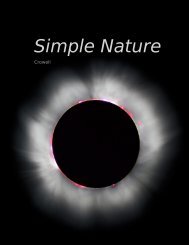Chapter 1 Conservation of Mass - Light and Matter
Chapter 1 Conservation of Mass - Light and Matter
Chapter 1 Conservation of Mass - Light and Matter
You also want an ePaper? Increase the reach of your titles
YUMPU automatically turns print PDFs into web optimized ePapers that Google loves.
e / A cannon fires cannonballs<br />
at different velocities, from<br />
the top <strong>of</strong> an imaginary mountain<br />
that rises above the earth’s atmosphere.<br />
This is almost the same<br />
as a figure Newton included in his<br />
Mathematical Principles.<br />
to deduce the general equation for gravitational energy. The equalarea<br />
law turns out to be a statement on conservation <strong>of</strong> angular<br />
momentum, which is discussed in chapter 4. We’ll demonstrate<br />
the elliptical orbit law numerically in chapter 3, <strong>and</strong> analytically in<br />
chapter 4.<br />
2.3.2 Circular orbits<br />
98 <strong>Chapter</strong> 2 <strong>Conservation</strong> <strong>of</strong> Energy<br />
Kepler’s laws say that planets move along elliptical paths (with<br />
circles as a special case), which would seem to contradict the pro<strong>of</strong><br />
on page 90 that objects moving under the influence <strong>of</strong> gravity have<br />
parabolic trajectories. Kepler was right. The parabolic path was<br />
really only an approximation, based on the assumption that the<br />
gravitational field is constant, <strong>and</strong> that vertical lines are all parallel.<br />
In figure e, trajectory 1 is an ellipse, but it gets chopped <strong>of</strong>f when<br />
the cannonball hits the earth, <strong>and</strong> the small piece <strong>of</strong> it that is above<br />
ground is nearly indistinguishable from a parabola. Our goal is<br />
to connect the previous calculation <strong>of</strong> parabolic trajectories, y =<br />
(g/2v 2 )x 2 , with Kepler’s data for planets orbiting the sun in nearly<br />
circular orbits. Let’s start by thinking in terms <strong>of</strong> an orbit that<br />
circles the earth, like orbit 2 in figure e. It’s more natural now<br />
to choose a coordinate system with its origin at the center <strong>of</strong> the<br />
earth, so the parabolic approximation becomes y = r − (g/2v 2 )x 2 ,<br />
where r is the distance from the center <strong>of</strong> the earth. For small<br />
values <strong>of</strong> x, i.e., when the cannonball hasn’t traveled very far from<br />
the muzzle <strong>of</strong> the gun, the parabola is still a good approximation<br />
to the actual circular orbit, defined by the Pythagorean theorem,<br />
r 2 = x 2 + y 2 , or y = r � 1 − x 2 /r 2 . For small values <strong>of</strong> x, we can use<br />
the approximation √ 1 + ɛ ≈ 1+ɛ/2 to find y ≈ r−(1/2r)x 2 . Setting<br />
this equal to the equation <strong>of</strong> the parabola, we have g/2v 2 = (1/2r),<br />
or<br />
v = √ gr [condition for a circular orbit] .<br />
Low-earth orbit example 14<br />
To get a feel for what this all means, let’s calculate the velocity<br />
required for a satellite in a circular low-earth orbit. Real low-earthorbit<br />
satellites are only a few hundred km up, so for purposes <strong>of</strong><br />
rough estimation we can take r to be the radius <strong>of</strong> the earth, <strong>and</strong><br />
g is not much less than its value on the earth’s surface, 10 m/s 2 .<br />
Taking numerical data from Appendix 5, we have<br />
v = √ gr<br />
�<br />
= (10 m/s2 )(6.4 × 103 km)<br />
�<br />
= (10 m/s2 )(6.4 × 106 m)<br />
�<br />
= 6.4 × 107 m2 /s2 = 8000 m/s<br />
(about twenty times the speed <strong>of</strong> sound).














